 Espalion
Espalion
Espalion
Pont vieux - Old bridge
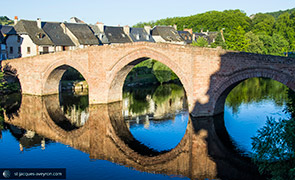
[lo Pònt vièlh]
« Santiago de Compostela was the supreme goal for countless thousands of pious pilgrims who converged there from all over Europe. To reach Spain pilgrims had to pass through France and the group of important historical monuments included in this inscription on the World Heritage List marks out the routes by which they did so. »
UNESCO letter of notification sent to the French government on 29 December 1998.
There was already a bridge in Espalion in the 10C. But the first mention of it in writing dates back to 1060.
That year, Baron de Calmont gave Conques Abbey a share of the toll levied on salt as it passed through from the Mediterranean to Aubrac and the Cantal Mountains (cheese dairies). In fact, in Espalion, both in the Middle Ages and under the Ancien Régime, there would be the biggest salt warehouse in Rouergue. The town came about because of the bridge and it was built around the path leading into it, Rue Droite [la carrièira drecha].
The lord derived financial advantage from the bridge (toll fees and dues for the town's fairs and markets).
The bridge appears to go back to the 13C, just like the two bridges in Entraygues sur Truyère, downstream.
The gothic structure, which has been modified several times, was initially equipped with three towers that used to house a guardroom, like the Pont Valentré bridge in Cahors.
In the 16C, during the Wars of Religion, a drawbridge in place of the last arch on the right bank was put in to add the final touch to this defensive system that was destroyed at the beginning of the 18C, the towers pulled down and the drawbridge replaced by a semi-circular arch.
There also used to be houses (shops?), in corbelled arrangement on either side. They were demolished in 1699, after being bought by the town.
Architecture
The bridge, built of red sandstone, probably dates back to the 13C.
It has a clearly outlined hump and four arches with a triple rolled edge (three arches on top of each other): the top one is quarter round shaped and slightly protruding which made it possible to widen the floor slab in the 18C. The arches form flattened ribs; the one on the left bank is semi-circular.
Pont Vieux is the oldest monument in the town. A bridge is mentioned in a deed of donation by the Lords of Calmont in 1060. The current structure built with a hump and four piers with triangular upstream and downstream cutwaters made from red sandstone, most probably dates back to the late 13C. The arches have a triple rolled edge (three arches on top of each other); the top one is quarter round shaped and slightly protruding which made it possible to widen the floor slab in the 18C. For a long time, this bridge had three towers and stalls arranged in corbel fashion on each side. During the Wars of Religion a drawbridge took the place of the last arch on the right bank. At the beginning of the 18C, the towers and stalls were pulled down and the drawbridge was replaced by a semi-circular arch, contrasting with the other three that are slightly pointed. It was put on the Historic Monuments list in 1888.
See the town tour brochure - Pont Vieux bridge
Pont Vieux, the Old Bridge Géolocalisation
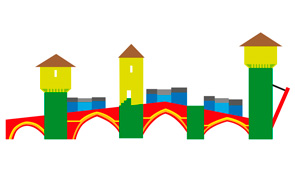
The structure, most probably dating back to the late 13C, is built of red sandstone. It has four arches with three arches on top of each other and a characteristic hump shape. Modified several times, the structure on which the Lords of Calmont used to collect toll fees was equipped with three towers that once housed a guardroom, like the Pont Valentré bridge in Cahors. In the 16C, a drawbridge was put up (right bank) to add to this defensive system. Destroyed in the early 18C, it also used to have small houses, pulled down c. 1700 after being bought by the town.
Calquières (former tanneries) Géolocalisation
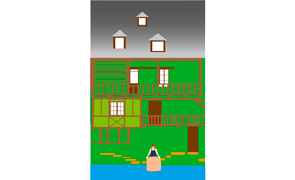
This is the name given to the old tanneries that stretch out along the right bank of the Lot. They are typical what with their wooden corbelled balconies and their sloping roofs. Just above the river, large flat stones jutting out (known as gandouliers) were used to wash the hides. They were laid out in staircase fashion so that whatever the level of the water, immersion was always possible. This prosperous industry, built on trade between Espalion and the neighbouring plateaux, carried on until the First World War.
Espalion
Espalion
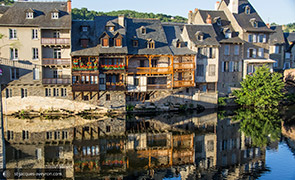
[Espaliu]
The town owes its prosperity to its strategic location, between Auvergne and Rouergue, and the only crossing point over the Lot that it commanded. From the 12C, Espalion became an important stage on the Route to Santiago de Compostela. The medieval town was built on the left bank of the Lot, to the west of an initial village.
Pont Vieux [lo Pont-Vièlh] – the Old Bridge first mentioned in 1060 – is the prominent feature that enabled the site to develop.
In 1266, the lord of Calmont bestowed franchises on the town which grew and built fortifications. Around 1300, there is mention of a hospice, still in connection with the passing through of pilgrims. In the letters patent issued by François I to establish the weekly market in Espalion, there is record of ' ...a large path and passageway, when coming or going from Languedoc and Toulouse to Paris and Lyon, in a fairly rich and fertile district, to which goods and merchandise flood in and merchants and other people pass through again and again...'.
In more recent times, trade between the Aubrac plateau and the valley made its mark on the town, with its huge livestock fairs or the tanneries that have left a very unusual architectural heritage on the banks of the Lot: the calquières [calquièiras] as they were called.
Did you know that two of the seven sections of the Route to Santiago de Compostela in France inscribed on the World Heritage List are in Aveyron? There are also four bridges inscribed and Sainte Foy abbey-church in Conques. This represents a remarkable heritage which stretches out over 80 km, from the Aubrac plateau to the Lot Valley. A flow of pedestrian travellers has carved out its path in this landscape.
The Routes to Santiago de Compostela are both unique and universal: they have been fashioned for over 1,000 years in step with feelings, chance encounters and a sense of sharing.
Unesco World Heritage
The year was 1945. The world was awakening from a nightmare that had gone beyond the bounds of horror. On 16 November, the United Nations Educational, Scientific and Cultural Organisation (UNESCO) was set up by the League of Nations.
Its aim: to build peace in the minds of men through education, science, culture and communication in order to further universal respect for justice, the rule of law, and human rights along with fundamental freedom for everyone, regardless of race, gender, language or religion. The 1972 Convention concerning the Protection of the World Cultural and Natural Heritage served UNESCO's ideal of peace and dialogue. Inscription on the World Heritage List consists in identifying, protecting and preserving, throughout the world, the cultural and natural heritage deemed to have exceptional universal value.
World Heritage sites belong to all the peoples of the world. There are currently nearly 1,000 'Properties' in 160 countries inscribed on the World Heritage List. France has 38 inscribed Properties.
The pilgrimage to Santiago de Compostela
In the pious Middle Ages, making a pilgrimage to a holy place, and the relics of the martyrs this place housed, was an essential deed in the life of a believer. The relic of a saint perpetuates his presence and his favourable influence. It provides protection, cure, succour and so on. Saint Peter, Saint Paul, the first Christian martyrs in Rome, the sites of Christ's life and passion in Jerusalem, attracted pilgrims from all over the Christian West. Around 830, the relics of the apostle James, beheaded by Herod in Palestine in 44 A.D. were miraculously discovered in Compostela (Galicia, Spain). The difficulties encountered by Christians to make their way to the Holy Land, together with the symbol that James the Apostle represented in the Reconquista*, drew the West's attention to this tomb that became one of the major pilgrimages right from the end of the first millennium. Thousands of pilgrims, kings, bishops and ordinary men carried out the journey to Galicia to meditate at the tomb of one of Christ's closest companions.
Four symbolic routes epitomized the countless routes that pilgrims converging on the Pyrenees used to follow. As they wended their way, they visited the many sanctuaries and called upon a litany of saints. They fulfilled their devotions and found charitable assistance.
Their routes played an essential part in trade and religious and cultural development during the Middle Ages.
The many buildings and places of worship that lined these routes are still evidence of that today.
* Reconquest of Muslim kingdoms on the Iberian Peninsula by Catholic rulers between 718 and 1492.
The Route in Aveyron
In 1998, the 'Routes of Santiago de Compostela in France' were inscribed on the World Heritage List because of their exceptional universal value.
This inscription took the form of a selection of 71 buildings and 7 stretches of the way which bore witness to the routes and places frequented by pilgrims wanting to go to Santiago de Compostela. In Aveyron, several edifices are recognised as World Heritage because they are outstanding landmarks on the route followed by pilgrims: the bridges over the Boralde in Saint Chély d'Aubrac, over the Lot in Espalion and Estaing and over the Dourdou in Conques; Sainte Foy Abbey-church in Conques, a place of pilgrimage in its own right dedicated to young Sainte Foy. Pilgrims on the Way of St James, referred to as jacquets, were advised to visit it as early as the Middle Ages;
Nasbinals (Lozère) / Aubrac / Saint-Chély-d'Aubrac : 17 km from the Aubrac plateau to its foothills; Saint Côme d'Old / Espalion / Estaing: 17 km along the Lot Valley.
Must-sees

A tour circuit helps you to discover the most beautiful historic buildings in Espalion.
These include pilgrim heritage (Pont Vieux – Historical Monument), the Vieux Palais (Old Renaissance Palace), the Chapelle des Pénitents chapel, the portal of the Chapel of the Ursuline Convent, the parish church, Saint Jean Baptiste Church (Historic Monument) which houses the Joseph Vaylet Museum of Popular Arts and Traditions and the very unusual Museum of Diving Suits, the Musée du Rouergue museum of old prisons.
Tourism and handicap
Several touch tables for the visually impaired have been set up. The first is just a few metres away from this board; the other two are at Pont Vieux (figure 18 on the map). In the Tourist Office, there is also a large-scale model of the itinerary through Aveyron of the Route to Santiago de Compostela.
The whole discovery trail in the town centre is accessible to people with reduced mobility, as are the cultural sites and public services.
Facilities for you
Between Aubrac and Conques, the local authorities of the area that the Puy en Velay route to Santiago de Compostela (GR®65) runs through have carried out a series of developments to help you discover this pedestrian and cultural route that is laden with meaning and history. Information boards line the 80 km section of the route. They will provide you with the tools to discover the heritage that is visible from the route (Romanesque monuments, landscape, geology, rural life, etc.)
A multimedia application (to download free of charge to smartphones and tablets - see below) helps to guide you and give you information about services (accommodation, food, visits, etc.).
You will find extra information on the elements to discover.
Facilities have also been designed for the safety and well-being of users: picnic areas, waterless toilets, footpaths alongside roads, signposts, path maintenance, etc.
The GR® and how to use it
The greatest care is taken to maintain the route and to welcome you in our villages so that the walk is a pleasant one for you. Nevertheless, you are responsible along the way.
Please take your rubbish away with you. There are lots of litter bins and toilets along the route.
The best way to observe nature is to respect it (no loud noises or shouting, avoid walking in big groups, etc.). Do not pick flowers, do not disturb the wildlife and herds of livestock. Respect fencing and private property.
Even on foot, please abide by the Highway Code. Warning: in foggy weather, some routes may be dangerous. Start when the fog has lifted or walk along the side of the roadway.
The route is a way to open up to nature, the life of the inhabitants and the traditions and history of the towns and villages you go through:
the people of Aveyron invite you to share their convivial way of life, be curious and feel free to talk to the people you meet!
Information: Espalion Tourist Office: 05 65 44 10 63 / Web : www.tourisme-espalion.fr
Comité Départemental du Tourisme de l’Aveyron (Aveyron Tourist Board): www.tourisme-aveyron.com
Espalion
The cattle market
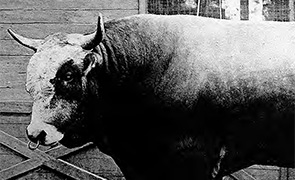
[lo fièiral]
As early as the 15C*, there is evidence of a cattle market where cereal from the causse, livestock from the Aubrac plateau and wine from the Lot valley were traded.
Around 1550, there were five cattle fairs per year which attracted merchants from France, Spain and Béarn.
* Register of ' estimas' (taxes) paid in Espalion in 1403
Up until the middle of the 20C, cattle markets maintained an important economic and social role. People came from all the surrounding villages, by cart or herding the livestock on foot, and then in the first vans.
Essentially for commercial reasons, going to the fair was also the opportunity to meet up and – for the men – to make merry in the cafés which were always full. Livestock markets gradually died out after the Second World War. They have been replaced by large markets of regional or European calling (Baraqueville, Laissac), which focus operations in big modern halls, suited to the new forms of negotiating livestock
Espalion
Diving apparatus
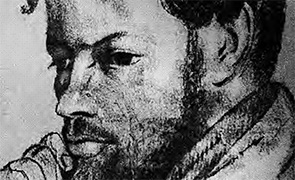
This strange statue of a deep-sea diver, on the right bank of the Lot, pays tribute to Benoît Rouquayrol, a state qualified mining engineer, and Auguste Denayrouze, a naval lieutenant.
In 1864, these two natives of Espalion presented a revolutionary invention: 'diving apparatus' equipped with a pressure regulator vessel that would be the 'birth certificate of the modern scuba set'.
Rouquayrol's idea was to provide French industry with equipment enabling a person to breathe, to move and to work freely in stifling environments, especially at the bottom of mining pits.
Denayrouze added to the invention by creating a suit made watertight by a layer of liquid rubber.
On 13 March 1865, Rouquayrol-Denayrouze's diving equipment was used for the first time in the navy to clean the hull of the battleship 'Le Taureau'. In 1867, the Paris World Fair awarded it its gold medal.
Anecdote...
In the 19C, fairs in Espalion provided the opportunity for demonstrations by cabussaires (divers) who indulged in fishing underwater in the Lot without any breathing apparatus.
A museum worth visiting
The Musée du Scaphandre Diving Suit Museum relates this extraordinary adventure from the great century of inventions.
It displays one of the very rare known specimens, listed on the Historic Monuments list in 2006.
Information from Espalion Tourist Office: 05.65.44.10.63
www.museeduscaphandre.com
Espalion
Château de Calmont d'Olt
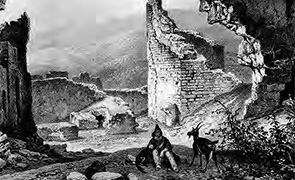
The fortified Château de Calmont d'Olt is an important landmark of medieval Rouergue. It is a perfect example of how châteaux adapted their architecture to technological breakthroughs and to changes in siege techniques. Perched on a basalt spur, this guard kept watch over the town of Espalion, the Lot Valley, the Aubrac plateau and the causses.
Traces are found as early as the 9C in the cartulary of Conques Monastery of the château site being occupied, so it is one of the oldest baronies in Rouergue; the de Calmont d'Olt family died out in 1298 2 with the passing of Raymond de Calmont d'Olt, Bishop of Rodez and architect 1 of Rodez Cathedral.
The construction of the present stronghold began in the 11C and went on until the 17C with the creation, during the Hundred Years' War, of an outstanding lower wall equipped with eight towers and thirty-two arrowslits and cannon ports. After that date, no further modifications were made and it would keep its medieval fortress look as we know it today.
3 In the 17C, deserted by its owners who preferred the more comfortable homes in the Lot Valley, it fell into ruin.
A château still very much alive
The remains of the château de Calmont were listed as a Historic Monument in 1992 and much has been done to preserve and enhance them. Today, visitors can find out about the archaeology of the site, but can also discover events that bring medieval culture back to life, how the machines of war worked and how to wield weapons, etc...
Contact : 05.65.51.69.92 / www.chateaucalmont.org
Espalion
Quilles de huit - eightpins
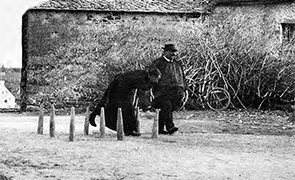
The statue of the 'Skittles player', by Michel Besson, celebrates the centenary of the coding of eightpins (1912) - a sport typically played in Aveyron - in its birthplace of Espalion.
This game, which was much played in many villages up until the end of the 19C, is still popular in Aveyron and a few surrounding areas, where it is associated with a French championship and an array of festivities.
The game is played on a clay pitch: eight wooden skittles are laid out in a specific pattern.
Each player has a skittle to play with [quilhon / 'quiliou' or tampe / 'tampe'] and a large hardwood ball weighing 4-6 kg. The game is played in nine shots, at short, medium and long distance (from 1 to 20 metres). The player has to knock down as many skittles as possible, firstly with their quiliou hit by the ball, then with the ball itself. Each skittle knocked down earns a point, 'une quille' (pronounced /key/), with a maximum total of 80. The teams (made up of 2 or 4 players) do not play against each other, each team plays its game and at the end of the round the team with the best score wins. A good individual score starts at 50 quilles and can border on 70 (the record is 68). A shot scoring no points is called a 'buffle'.
The game, codified in 1912 in Espalion, celebrated its centenary in 2012.
There is an exhibition on it at the Museum of Popular Arts and Traditions.
Espalion
On the route of Santiago de Compostela in Aveyron

[pel camin romiu roergàs]
The 17 kilometres from Saint Côme d'Olt to Estaing are inscribed on the World Heritage List under the 'Routes of Santiago de Compostela in France'. In the same way as the section between Nasbinals and Saint Chély d'Aubrac (17 km), the route between Saint Côme d'Olt and Estaing is one of the typical examples of what the path followed by pilgrims might have been like in the past.
Five further sections of the route from Le Puy en Velay, the Via Podiensis, in the Lot, Gers and Pyrénées Atlantiques, illustrate the route followed by pilgrims during the Middle Ages. 71 bridges, religious buildings or hospices, located in 13 regions, have also been inscribed on the World Heritage List for the same reason since 1998.
They are milestones on the routes followed by jacquets (the name given to pilgrims on their way to Santiago).
They bear witness to the spiritual and material aspects of the pilgrimage during the Middle Ages. Nowadays, these routes have opened up as hiking paths. Since the 1990s, a large number of walkers have travelled these paths, whether for cultural or spiritual reasons.
UNESCO World Heritage Géolocalisation
'Since wars begin in the minds of men, it is in the minds of men that the defences of peace must be constructed'.
Ellen Wilkinson, Minister of Education for Great Britain at the inaugural session of UNESCO.
In 1945, the world was awakening from the nightmare of war.
On 16 November, the United Nations Educational, Scientific and Cultural Organisation (UNESCO) was set up by the League of Nations. Its aim: to build peace in the minds of men through education, science, culture and communication in order to further universal respect for justice, the rule of law, and human rights along with fundamental freedom for everyone, regardless of race, gender, language or religion.
UNESCO's action in aid of world heritage serves this cause. Inscription on the World Heritage List consists in identifying, protecting and preserving, throughout the world, the cultural and natural heritage deemed to have exceptional universal value. Its loss would be irreplaceable.
There are currently nearly 1,000 'Properties' in 160 countries inscribed on the World Heritage List, 38 of which are in France.
Saint-Côme-d’Olt / Espalion / Estaing Géolocalisation
This part of the Lot Valley is of outstanding scenic interest, despite the large-scale urbanisation of Espalion. On the right bank, the well-exposed slopes are mainly limestone. They have enabled vineyards to be planted, a major component of the Eucharistic ritual, in an area well into the Massif Central. On the left bank, the slopes, where the former cereal-growing plateau of the causse Comtal ends, bear the hallmark of a variety of volcanic formations.
The most important is Roquelaure*, a basalt lava flow that stretches out over more than two kilometres to form a ridge. The alternation of geological features is spectacular, with the presence of pebbles and alluvial deposits, red earth, limestone plateaux and schistous areas [segalars] creating extremely diverse vegetation and farming practices that have an impact on the traditional habitat.
This way has been followed by travellers and pilgrims who have enjoyed an easy communication route over this section of their journey. The Romanesque buildings that line the route (church of Perse, church of Saint Pierre de Bessuéjouls) and the bridges [pònts romius] over the Lot in Espalion and Estaing are evidence of this.
Espalion
Vieux Palais, Old Renaissance Palace
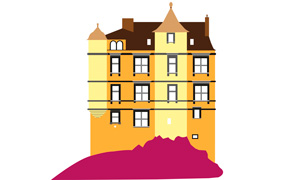
The Vieux Palais (used as a courthouse in the 19C) is a Renaissance building erected in 1572 by Bernardin de la Valette, tasked by the consuls with defending Espalion during the Wars of Religion. Standing on a rocky spur facing the Lot, its northern façade, reproduced below, is made up of 3 floors with mullioned or transom windows set in it.
The Palace boasts a robust northern tower and a delicate corner turret. The latter, built of dressed stone and corbelled beneath a cone-shaped roof, is decorated with a carved corbel where a wavy frieze stands out.
Espalion
Place du Griffoul
Place du Griffoul (fountain in Occitan), between Rue Droite and Pont Vieux bridge, was the town's main square. The water from the fountain came from a spring tapped at the foot of Butte de Calmont hillock. The market used to be held in this square surrounded by houses built above arches. A covered hall with a stone used to measure grain stood in the middle of it. The square was completely altered when Pont Neuf bridge was built and the houses along the banks of the Lot destroyed to make way for the current Quai Henri Affre.
Espalion
Vieux Palais, Old Renaissance Palace
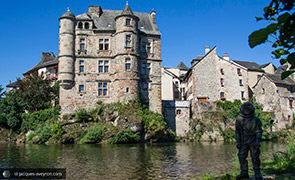
The Renaissance-style building, commonly called the Old Palace (because it was a courthouse in the 19C) was built in 1572 thanks to the 'noble Bernardin de la Valette' tasked by the consuls with Espalion's defence during the Wars of Religion. Standing on a rocky spur, facing the Lot, it artfully combines the robustness of its northern tower and the delicacy of the corner turret overlooking the Foirail. The latter, built of dressed stone and corbelled beneath a cone-shaped roof, is decorated with a lavishly carved corbel where an attractive wavy frieze stands out. At the top, it is flanked by a small loggia. Transom and mullioned windows are set into the façade on all three floors and highlighted by prominent stringcourses. Made available by the Association for the Revival of the Old Palace, this picturesque building has been fitted out to welcome artists-in-residence programmes.
See the town tour brochure - The Old Palace (Vieux Palais)

The Vieux Palais (used as a courthouse in the 19C) is a Renaissance building erected in 1572 by Bernardin de la Valette, tasked by the consuls with defending Espalion during the Wars of Religion. Standing on a rocky spur facing the Lot, its northern façade, reproduced below, is made up of 3 floors with mullioned or transom windows set in it.
The Palace boasts a robust northern tower and a delicate corner turret. The latter, built of dressed stone and corbelled beneath a cone-shaped roof, is decorated with a carved corbel where a wavy frieze stands out.
Espalion
Chapelle des Ursulines chapel
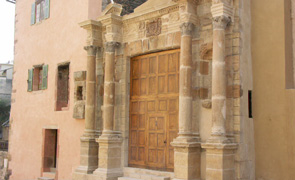
The Ursuline Chapel used to belong to a vast group of buildings, the Ursuline Convent, located outside the town's enclosed faubourg, on the right bank, where the current post office stands. Building began in 1656 and was only completed in 1674. When it was pulled down in 1968, only the stones from the main gate were kept. They were put back up again in 2001, on the left bank, at the entrance to the Foirail (former cattle market) on rue Saint Joseph. The four columns with Corinthian capitals used to frame the recesses for statues of Saint Ursula and Saint Augustin which 'disappeared' in the 20C. Above the lintel is the carved coat of arms of the Lords of Calmont who founded the convent. The broken pediment used to flank a statue of Our Lady. The fact that this chapel was destroyed is all the more regrettable since it was one of the rare illustrations of Rouergue classical style in the 18C.
Espalion
Foirail
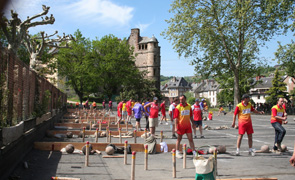
This former fairground has become a pleasant place through which to stroll in summer, beneath the shade of the hundred-year-old plane trees bordering the Lot. It is also a leisure area where the canoe and kayak base, camp site, swimming pool, crazy golf, tennis courts, childrens' playground and other sports pitches are all to be found. A huge area has been set aside for the game of eightpin skittles (jeu de quilles de 8) symbolised by the statue of a player erected in 1992. From the riverbank, the Old Renaissance Palace, a line of age-old houses and Pont Vieux bridge mirrored in the deep waters of the Lot form a stunning picture. On the right bank, a statue of a deep-sea diver, in tribute to the inventors of the autonomous diving suit who came from Espalion, stands alongside the Lot.
(*) The bust of Joseph Vaylet, a member of the Félibrige literary association and founder of the Museum of Popular Arts and Traditions, stands in the garden near Square Albert Girbal (an Occitan writer) and the Old Renaissance Palace.
Espalion
Chapelle des Pénitents Blancs chapel
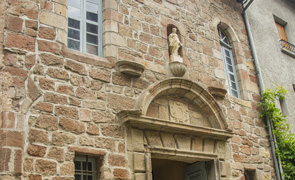
Built in 1700, disused and then rehabilitated as from 2001, the Chapel of the White Penitents, whose brotherhood came into being in 1668, has a distinctive feature on its façade: a door surrounded by a jointed facing and topped by an arched pediment. A bull's eye window and two semi-circular arched windows surround a recess housing a statue of the Virgin. Inside, an 18C reredos, made of painted and gilded wood, features the Circumcision of Jesus in the centre, the Nativity on the right and the Adoration of the Magi on the left. The twisted columns and pilasters crowned with flowerpots are inspired by Baroque decoration. Among the various pieces restored at the instigation of the Friends of the Chapel, it is worth mentioning: an extremely rare 17C Christ made of pasteboard on a processional cross and an 18C painted wood Christ lying in the tomb. On the floor, funeral flagstones bear some engraved names and initials, a heart surmounted by a cross and the drawing of an object that looks like a tanner's tool.
Espalion
Maison d’Assézat house
On Place du Puits square is an old town house built during the 16C. It was the birthplace of Pierre Assézat, a merchant who made a fortune by selling pastel (a vegetable dye), who had the lavish 'Hôtel d'Assézat', seat of the Académie des Sciences, Inscriptions et Belles Lettres, built in Toulouse in the Renaissance style.
Espalion
Former Church of St Jean Baptiste
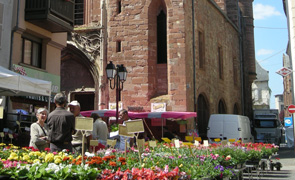
On the market square
This former parish church, construction of which began in the late 15C, was given a beautiful flamboyant Gothic-style door in 1508 which is now badly damaged and worn. It is the work of a great artist, Antoine Salvanh, architect of the steeple of Rodez Cathedral from 1512 on. The quadrangular belfry used to house the town clock.
See the town tour brochure - St Jean
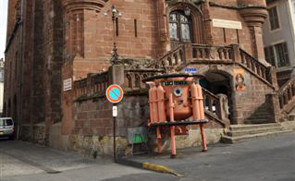
On the boulevard
Disused following the construction of a new church, it became the Town Hall between 1897 and 1948. A neo-Gothic façade was grafted onto its truncated apse and flanked by two turrets surrounding a loggia topped by the town's coat of arms. A monumental staircase with two flights of stairs leads to the first floor which has housed part of the Joseph Vaylet Museum of Popular Arts and Traditions since 1975. The ground floor is home to the Diving Suit Museum. Note the lovely hexagonal steeple and spire that have recently been restored.
Espalion
Musée du Scaphandre Diving Suit Museum
This museum was created by Lucien Cabrolié and based on the inventions by two natives of Espalion, Benoît Rouquayrol and Auguste Denayrouze who, in 1864, invented the first modern diving suit in the history of diving. Jules Verne took inspiration from their device to equip Captain Nemo in his novel '20,000 Leagues Under the Sea'. The first trials were carried out in the Lot. Many rare, even unique, items attract specialists from around the world. A statue of a diver, in tribute to the great inventors, was put up in 2000 on the right bank of the Lot.
Espalion
Musée du Rouergue Museum
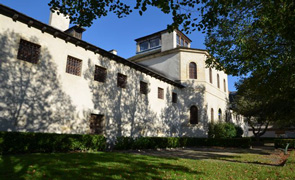
Located in the town's former prison, it houses various collections of art and traditions of the Rouergue area. The prison was built in 1838 and was one of the first solitary confinement buildings in France. Its design was extremely advanced as far as hygiene, security and moral standards were concerned. Men were to be found in the right wing, women in the left and the main wing served as a chapel. It was closed in 1933 when prison buildings were centralised (the cells on the first floor are used to store the library collections belonging to the Joseph Vaylet Museum, a treasure trove of more than 6,000 works mainly about the traditions, history and language of Oc: access is for researchers only).
Espalion
Tour Michou tower
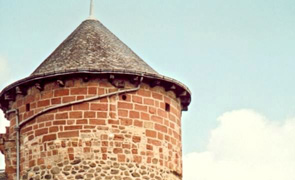
Last remaining tower of the six that formed the fortified enclosure of Espalion, built between the 14C and 15C. It protected the population during the Hundred Years' War and later the Wars of Religion.
Espalion
Parish church
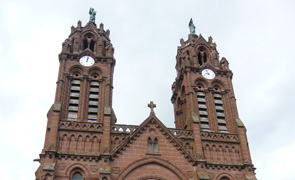
Built of pink sandstone in neo-Gothic style at the end of the 19C. Legend has it that its 45-metre-high twin towers wanted to remind people of the famous steeple of Rodez Cathedral! They are crowned by 3-metre-high statues of the Virgin and Saint Joseph. The three-door façade is decorated with statues of the Good Shepherd, Saint John the Baptist and Saint Hilarian, patron saint of the town. Inside, fixed to a wall of the southern apsidiole, a group made of bronze, carved in high relief by Aveyron artist Denys Puech portrays the martyrdom of Saint Hilarian. In the arms of the transept a painting portrays Saint Joseph protecting the town at the foot of Château de Calmont. This ex-voto was painted in 1658 following a terrible plague epidemic. Opposite, in the north arm, a lovely painted canvas showing the Last Supper has recently been restored. The main altar and its monumental reredos are made of marble from Poitou, as is the pulpit.
Espalion
Calquières (former tanneries)

This is the name given to the old tanneries that stretch out along the right bank of the Lot. They are typical what with their wooden corbelled balconies and their sloping roofs. Just above the river, large flat stones jutting out (known as gandouliers) were used to wash the hides. They were laid out in staircase fashion so that whatever the level of the water, immersion was always possible. This prosperous industry, built on trade between Espalion and the neighbouring plateaux, carried on until the First World War.
Espalion
Pont Vieux, the Old Bridge

The structure, most probably dating back to the late 13C, is built of red sandstone. It has four arches with three arches on top of each other and a characteristic hump shape. Modified several times, the structure on which the Lords of Calmont used to collect toll fees was equipped with three towers that once housed a guardroom, like the Pont Valentré bridge in Cahors. In the 16C, a drawbridge was put up (right bank) to add to this defensive system. Destroyed in the early 18C, it also used to have small houses, pulled down c. 1700 after being bought by the town.









































